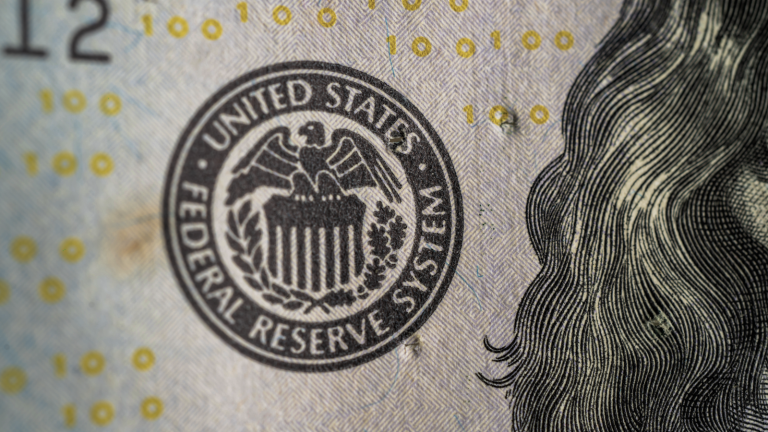The Federal Reserve just cut interest rates by a quarter point – the second reduction this year – bringing benchmark rates to a three-year low.
Markets should have cheered. Instead, they sold off.
Because Fed Chair Jerome Powell made it clear in the post-meeting press conference that another cut in December is not guaranteed. “Policy is not on a preset course.”
In response, Treasury yields jumped, and stocks sagged. The Dow and S&P 500 both ended Wednesday in the red.
Now, here’s where I’m going to say something that feels borderline heretical in modern finance:
Increasingly, the Fed does not matter – not in the way it used to.
Once, a hawkish Fed would kill stocks, and a dovish one would ignite a rally. But we are in a new regime now. In today’s market, artificial intelligence is the new center of gravity. And AI does not care whether Jerome Powell cuts again in December…
How the Fed Lost Its Grip on Markets
Let’s start with what actually happened inside the Eccles Building.
The central bank cut for the second time this year, bringing the policy rate down another quarter point. Great. Streamers will refinance their credit lines and midsize banks can breathe a tiny bit easier.
Then, at the post-meeting press conference, Jerome Powell stepped up to the mic and immediately poured cold water over Wall Street’s endless-cut fantasy. He told us flat out: a December cut is not a foregone conclusion, and there are “strongly differing views” inside the central bank regarding the best path for the future.
The knee-jerk read was: “Uh oh. The Fed might go slower. Risk assets are in trouble.”
That reaction would make total sense… in 2016, ’19, or ’22… but not now.
Today’s market is not about car loans, mortgage refinancing, or small business lines of credit.
AI is now the economy (at least the part Wall Street cares about).
The New Center of Gravity: AI Capex
Let’s be honest. The things that once propped up the market aren’t doing so great right now.
- Consumer credit: Revolving balances rose 7.3% year over year through August, per the latest Fed G.19 report – still growing, but slowing from early 2024’s double-digit pace.
- Housing: The median existing-home price is up 4.5% year over year, while housing affordability remains near a 40-year low, according to the National Association of Realtors.
- Autos: The average new-car payment is now about $750 a month (Edmunds Q3 data), roughly equivalent to a mid-2000s mortgage payment.
- Regional banks: Research from Wharton School highlights that “almost one-third of U.S. commercial mortgage dollars sits on regional-bank balance sheets” and that “reported delinquencies understate risks…by a factor of four” for such banks.
Instead, the thing keeping U.S. equities afloat is the AI buildout…
Data centers. Power infrastructure. High-performance chips. Advanced packaging. Cooling. Grid upgrades. Industrial equipment.
That is the capex supercycle.
And crucially, it is mostly not rate-sensitive. It’s driven by strategic urgency and expected long-term productivity/ROI – not by whether your cost of capital is 4.0% or 4.25%.
Powell openly acknowledged this in the post-meeting press conference, saying, “I don’t think that the spending that happens to build data centers all over the country is especially interest sensitive.”
In other words, the Fed Chair essentially said, on camera, that the hottest capex boom in the country is not really something rate policy can slow.
That’s why certain AI-adjacent names keep ripping in the face of every macro panic – diametrically different from every other investment boom of the past few decades.
Why Rate Policy No Longer Dictates Risk Appetite
Normally, when money gets more expensive, capex slows. Companies delay factories, pause deployments, push projects. The Fed tightens, and demand cools.
But not now…
Because this time around, the buyers are among the richest entities in history; cloud platforms and megacaps with $30-, $40-, $50 billion in quarterly operating cash flow. They’re not paying with loans. And when they do lever up to accelerate buildouts, it’s because they believe the long-term returns justify almost any near-term financing cost.
You don’t kill that psyche with 25 basis points.
And that is lethal to the old “Fed-is-God” market narrative.
For much of the post-’08 era, the model was: The Fed controls money. Money controls growth. Growth controls earnings. Earnings control stocks.
Now it looks more like this: AI demand → hyperscaler capex → revenue growth and margin expansion for AI suppliers → index earnings power → rising stock prices.
Notice who’s not involved there? The Fed.
In fact, the central bank is starting to look like a side character reacting to the AI buildout, not the other way around. Powell is being dragged along by what the AI economy is doing to labor, productivity expectations, power demand, and capex – not ‘steering’ those things in the traditional sense.
That’s why I say the Fed doesn’t really matter anymore; at least not in the way that moves stocks week-to-week.
However…
Where the Fed Still Matters: Valuations and System Risk
I am not saying the Fed is irrelevant. I’m saying the mechanism of influence has changed.
There are two big places the Fed still impacts equities:
Valuations
Even if AI demand doesn’t slow one bit, higher Treasury yields still push down valuation multiples.
When Powell hints that December cuts aren’t guaranteed, yields jump, the discount rate on future cash flows goes up, and your spreadsheet spits out a lower fair value for growth stocks. That’s why, even with news of a rate cut, we still saw the Nasdaq wobble.
So, yes, the Fed can slap 3% off your favorite AI name in an afternoon just by adjusting the tone. But those same AI names keep posting absurd revenue growth and ridiculous margins because of that capex supercycle. So, even if the multiple compresses a little, that pressure is offset by earnings upgrades.
That is not a setup where you panic-sell strength. That is a setup where you buy dips caused by Fed jawboning…
Because the earnings machine underneath hasn’t changed.
Break Risk
The Fed’s second lever is structural.
Rates shape the plumbing of the financial system itself.
If Powell stays too tight for too long, something in the non-AI economy can crack: tighter credit hits small business, job losses accelerate, the consumer pulls back, maybe a well-known company goes belly-up.
If that happens, even the AI story catches some shrapnel. Enterprises might delay AI rollouts. Startups might pause. Budgets might get staggered instead of front-loaded. The ripple effect is slower, but it’s real.
That scenario is the bear case; your left-tail risk.
Though, importantly, that’s not where we are right now.
Labor is cooling, not imploding. Credit is tight, not seizing. Consumer spend is bending, not collapsing. The Fed is cutting, not hiking. Powell is sounding cautious, not aggressive.
So, yes, theoretically, the Fed still has the power to break the plumbing of the broader economy. But in the here and now, that isn’t happening, which means that left-tail risk is a future possibility and not a present constraint.
The Bottom Line: Tune Out the Noise, Follow the Capex
Right now, the engine of equity-market earnings growth is AI capex.
- That capex is being funded by cash-rich megacaps and justified on decade-long ROI assumptions.
- The Fed can tweak yields and wobble multiples, but it cannot meaningfully slow that capex in the next few quarters.
- The only real way the Fed kills this bull is by causing a true economic break in the rest of the system – and we’re not seeing that yet.
Therefore, in the near term, Powell’s remarks about the path forward for interest rates is just background noise.
Tune it out, and focus on AI.
Own the companies building the compute backbone of the next industrial platform, the power equipment firms wiring up the new grid for those data centers, the infrastructure enablers of the most aggressive private-capex boom we’ve seen in modern history.
Because if the Fed cuts in December, AI spending will be big. And if it doesn’t, AI spending will still be big.
Hyperscalers will keep writing billion-dollar checks. Suppliers will keep printing fat margins. Earnings will keep getting revised higher, and the market’s center of gravity will keep drifting toward the companies levered to that flywheel.
The AI capex supercycle is the main character in this market story – the one driving actual cash.
So, bet on the only thing in today’s economy that’s both unstoppable and, for now, untouchable.
A private-sector investment machine is underway. And the same forces driving today’s AI capex boom – more compute, smarter algorithms, and a global race for efficiency – are already spilling into the next frontier: humanoid robotics.
And just like AI, the biggest gains will come from the suppliers: the actuator makers, sensor firms, and precision-chip producers building the muscle and nerves of the automation era.
Find out which names could lead this next industrial revolution.


